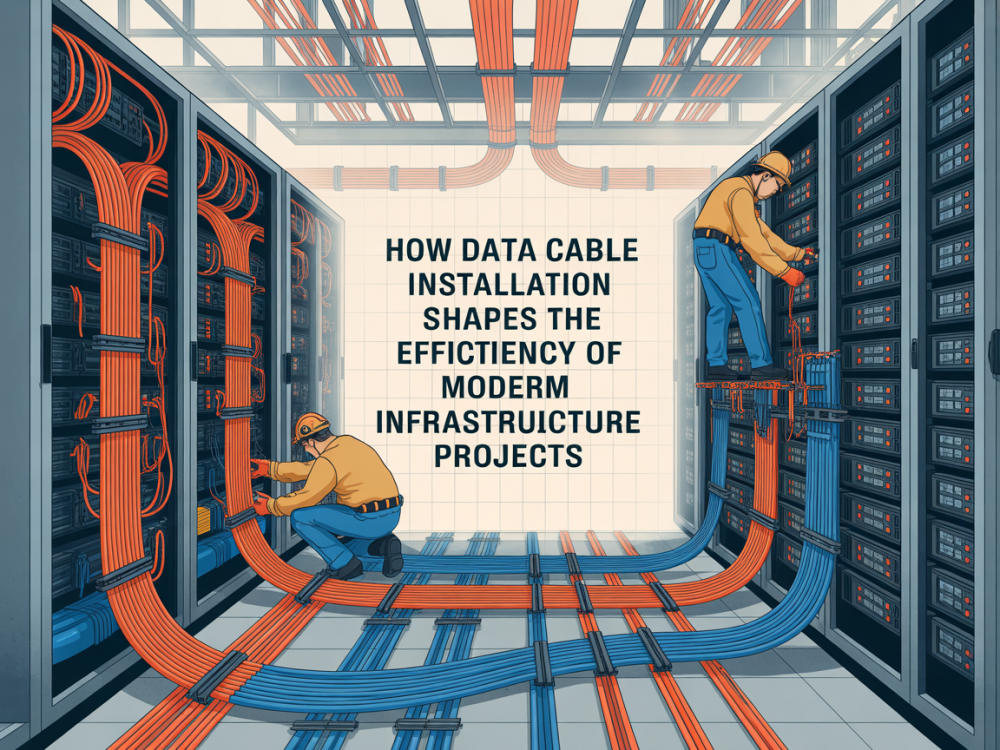The communication networks of today’s digital era are heavily reliant on more than just wireless technology; various factors greatly influence their capacity to communicate. A reliable connection is like an iceberg; only the tip is visible, and that is the wireless technology. However, be sure that just below the tip lies a whole network of data cables that are very complex, and that network is the result of skilled designers, installers, and maintainers. Starting with business communications and extending to public safety systems, data cable installation that works efficiently can be regarded as a major factor that determines the success of telecom infrastructure projects in the modern age.
1. The Backbone of Modern Telecom Infrastructure
Telecom infrastructure refers to the necessary elements that are responsible for the existence of communication at present, and they consist of both physical and digital frameworks. The components include towers, data centers, fiber-optic cables, switches, routers, and cloud-based systems. Though wireless technology often gets the most attention, the truth is that, in the end, wireless signals rely on wired connections for speedy and low-latency data transmission.
Telecom companies such as BT Group, Verizon, AT&T, and Vodafone are putting a lot of money into their networks by running large-scale infrastructure projects, which are not only based on wireless technology but also on wired technology. Among all the activities that are being done, the installation of robust data cables that enable core networks, edge devices, and end-users’ connection with little signal loss is the most important one.
Moreover, public and private organizations join forces with infrastructure experts to guarantee their systems are capable of accommodating the increasing requirements for speed, security, and sustainability. The global rollout of 5G, Internet of Things, and smart city networks has made it necessary to install high-tech cabling systems that can manage the higher bandwidth and the heavy volume of data that comes along with it.
2. The Role of a Telecom Project Manager in Infrastructure Development
A telecom project manager is the one who can hardly ever be replaced in the case of successful telecom infrastructure deployment. From the initial sketch to the final touch, the project manager is responsible for the whole process and, at the same time, is making sure that every step corresponds to the technical requirements, safety regulations, and budget limits.
Key duties include:
- Planning and Coordination: Site assessment, resource requirement determination, and roadmap creation for execution are all actions performed by project managers. They act as a link between engineers, technicians, and stakeholders to make the operations flow smoothly.
- Risk Management: They spot and mitigate risks in advance, from permitting delays to environmental constraints, so that there will be no interruptions.
- Quality Control: They monitor the compliance of cabling, routing, and installations with such industry standards as ISO/IEC 11801 and TIA/EIA-568.
- Compliance and Safety: The management of compliance with local regulations and safety codes protects both the workers and the end-users.
The Telecommunications Industry Association (TIA) and the International Telecommunication Union (ITU), along with other prominent international organizations, set standards that project managers have to follow. One of the significant benefits of these standards is the facilitation of global interoperability, network stability, and service quality.
3. Why Data Cable Installation Matters More Than Ever
Fiber optics and wireless systems are usually the main focus, yet cabling is still the one that delivers the telecom performance. Data cables, whether they are copper or fiber, are always the physical medium that moves vast amounts of information between data centers, switching hubs, and user devices.
3.1. Precision and Planning in Installation
A well-designed cabling layout that is well-designed can significantly lower data loss and latency. Detailed routing, labeling, and terminating make each connection able to use the full bandwidth. Bad cabling methods, however, can cause interference with signals, a reduction of data transfer rates, and more expensive maintenance.
3.2. Future-Proofing with Fiber Optics
The transition to installing fiber optics indicates the direction of the industry towards faster and more reliable communication. Fiber cables, in contrast to copper, carry data through light, which enables faster communication over longer distances. The use of fiber optics in cloud migration and edge computing applications has escalated, and thus, the need for them to keep communication running smoothly has become crucial.
3.3. Energy Efficiency and Sustainability
Energy efficiency is now at the forefront of modern cable installation methods. The use of energy-efficient routing and insulation results in less power consumed by the cooling systems and network devices. Organizations are increasingly using recyclable materials and eco-friendly installation methods, which not only help in meeting their own environmental goals but also align with the United Nations’ Sustainable Development Goals (SDGs).
Conclusion
The meticulous planning by a telecom project manager followed the delivery of telecom infrastructure services, and each phase led to a world that is more connected and efficient. The constant interaction among engineers, regulatory authorities, and international organizations is what keeps telecom networks, the backbone of our digital economy, strong, fast, and ready for the future.
Frequently Asked Questions
1. Why is data cable installation so necessary in telecom infrastructure projects?
The installation of data cables builds up the physical base of all telecom systems. Even the wireless technologies depend on wired backbones for fast data transfer. Properly installed cables are essential for the functioning of communication networks because they cut down delays, lose very little signal, and provide long-term reliability.
2. What role does a telecom project manager play in infrastructure development?
A telecom project manager assumes responsibility for the total process—from planning to design, through installation to quality assurance; the project manager organizes the work of technicians, engineers, and regulatory agencies to make sure the project complies with industry standards, has its budget kept, and is done safely and efficiently.
3. How do telecom infrastructure services support data cable installation?
Telecom infrastructure services consist of an array of activities, starting from the design of the network to the installation of cabling and going through testing, certification, and maintenance. The integration of the physical and digital systems is guaranteed through these services, which in turn provide seamless connectivity to the enterprises, data centers, and intelligent city networks.
4. What types of data cables are used in modern telecom systems?
The most typical varieties of cables are copper and fiber-optic cables. Copper cables are cheaper to use for short distances; on the other hand, fiber-optic cables are ideal for modern high-capacity networks because their being able to provide more than 2,000 times the standard bandwidth and transmit data faster than usual over long distances.
5. How does fiber-optic technology improve telecom efficiency?
Data is transferred via light signals in fiber optics, which makes it possible to have significantly higher speeds and greater distances of transmission when compared to copper wires. Fiber optics is also less affected by electromagnetic interference, so that there is a more reliable and effective communication system for the enterprises and authorities


